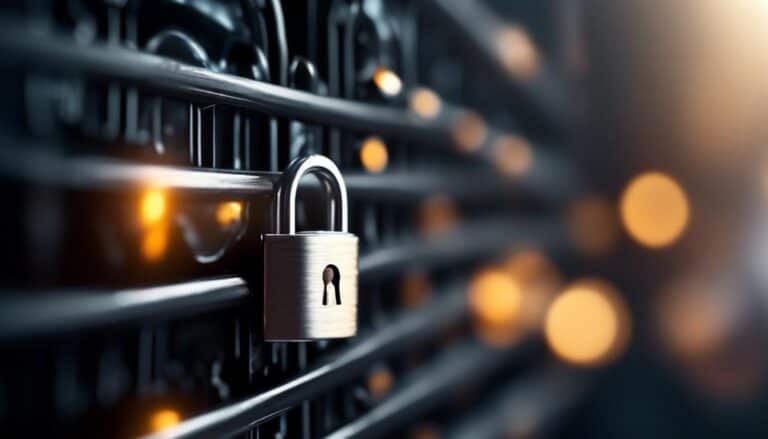Unlocking the Secrets to Ironclad File Security in the Digital Age
You may be thinking, 'Is file security really that important in the digital age?' Well, in a world where cyber threats are becoming increasingly sophisticated, protecting your files from unauthorized access is no longer a luxury, but a necessity.
The secrets to ironclad file security lie in understanding the potential threats and implementing the essential elements that safeguard your data. From encryption to access controls and file monitoring, this discussion will unveil the strategies and techniques that will keep your files safe from prying eyes.
So, how can you ensure the utmost security for your digital assets? Let's explore the key components together.
Key Takeaways
- File security and cybersecurity are crucial for protecting sensitive information and preventing financial losses, reputational damage, and legal liabilities.
- Understanding different cyber threats such as malware, ransomware, phishing, DDoS attacks, and social engineering is essential for implementing effective security measures.
- Essential elements of ironclad security include multi-factor authentication, secure file transfer protocols, data loss prevention, endpoint protection, and regular software updates and patches.
- Encryption and access controls, including user authentication, role-based access control, regular access reviews, audit logging, and encryption of file access credentials, play a significant role in ensuring the confidentiality, integrity, and availability of data.
Importance of File Security

File security is essential in protecting sensitive information from unauthorized access or misuse. In today's digital age, the importance of data privacy and securing sensitive information can't be overstated. With the increasing reliance on technology for storing and transmitting data, it's crucial to implement robust security measures to safeguard valuable information.
The importance of file security lies in ensuring the confidentiality, integrity, and availability of data. Confidentiality ensures that only authorized individuals have access to sensitive information, preventing unauthorized disclosure. Integrity guarantees that data remains accurate and unaltered, while availability ensures that authorized individuals can access the information when needed.
Securing sensitive information isn't only important for individuals but also for organizations and businesses. Data breaches can lead to severe consequences, including financial losses, reputational damage, and legal liabilities. Protecting customer data isn't only a legal requirement but also essential for maintaining trust and loyalty.
Implementing strong file security measures involves using encryption, access controls, firewalls, and regular security audits. It also requires educating users about best practices for data protection, such as using strong passwords, avoiding phishing scams, and regularly updating software.
Understanding Cyber Threats
To ensure the ironclad security of your files in the digital age, it's crucial to understand the various types of cyber threats that exist.
Cyber attacks come in many forms, including:
- Malware
- Ransomware
- Phishing
- DDoS attacks
Types of Cyber Attacks
Cyber attacks come in various forms and can pose significant threats to the security of digital systems and data. It's important to be aware of the types of cyber attacks to better understand how to protect against them.
Here are five common types of cyber attacks:
- Malware: Malicious software such as viruses, worms, and Trojans that infect systems and disrupt operations.
- Phishing: Deceptive emails or websites that trick users into revealing sensitive information like passwords and credit card details.
- Denial of Service (DoS) attacks: Overwhelming a system's resources to make it unavailable to users.
- Ransomware: Encrypting files or locking systems until a ransom is paid to the attacker.
- Social engineering: Manipulating individuals to gain unauthorized access or divulge confidential information.
Understanding these types of attacks is crucial for effective cyber attack prevention. By implementing robust security measures and educating users, you can mitigate the risks associated with these threats and protect your digital assets.
Importance of Cybersecurity
In today's digital landscape, safeguarding against cyber threats is paramount to ensuring the integrity and security of sensitive information. Cybersecurity measures play a vital role in protecting individuals, businesses, and organizations from various cyber attacks.
With the increasing sophistication of hackers and the ever-evolving nature of cyber threats, it's crucial to implement robust cybersecurity measures to safeguard against unauthorized access, data breaches, and other malicious activities.
Securing sensitive data is of utmost importance, as it contains valuable information that, if compromised, can lead to significant financial losses, reputational damage, and legal consequences.
Essential Elements of Ironclad Security

Implementing robust encryption protocols is a fundamental component of ensuring ironclad file security in the digital age. To achieve the highest level of protection for your sensitive data, consider the following essential elements:
- Multi-factor authentication (MFA): Enhance your security by requiring multiple forms of authentication, such as passwords, biometrics, or smart cards. This adds an extra layer of defense against unauthorized access.
- Secure file transfer protocols (SFTP): Use SFTP instead of regular FTP to encrypt file transfers and safeguard data integrity during transmission, preventing interception or tampering.
- Data loss prevention (DLP): Employ DLP solutions to monitor, detect, and prevent the unauthorized transmission of sensitive information, ensuring that confidential data remains within authorized boundaries.
- Endpoint protection: Deploy comprehensive endpoint protection software to defend against malware, ransomware, and other malicious attacks that could compromise your files and systems.
- Regular software updates and patches: Stay vigilant by keeping your software and operating systems up to date with the latest security patches. This minimizes vulnerabilities that hackers could exploit.
Encryption: The Key to File Protection
To ensure ironclad file security in the digital age, encryption serves as the key to protecting your sensitive data. Encryption techniques convert your files into unreadable code, making it nearly impossible for unauthorized individuals to access your information. This process involves using complex algorithms to scramble your data, which can only be deciphered with the correct encryption key.
When it comes to file protection, one of the most significant concerns is securing data stored in the cloud. Cloud storage offers convenience and accessibility, but it also poses potential risks. Encrypting your files before uploading them to the cloud ensures that even if a breach occurs, your data remains secure.
There are various encryption techniques available to safeguard your files. One common method is called symmetric encryption, where the same key is used for both encryption and decryption. Asymmetric encryption, on the other hand, uses a pair of keys – a public key for encryption and a private key for decryption. This method provides an extra layer of security as the private key is never shared.
Implementing Access Controls

Ensure robust file security in the digital age by implementing access controls that restrict unauthorized individuals from accessing your sensitive data. Access control implementation and file access management are crucial steps in safeguarding your files. Here are five key considerations to help you effectively implement access controls:
- User authentication: Require users to verify their identities through strong authentication methods, such as passwords, biometrics, or two-factor authentication.
- Role-based access control: Assign specific access privileges based on user roles to ensure that individuals only have access to the files they need to perform their job functions.
- Regular access reviews: Conduct periodic reviews to ensure that access privileges are up to date and aligned with the principle of least privilege.
- Audit logging: Implement comprehensive logging capabilities to track and monitor file access activities, enabling timely detection of any suspicious or unauthorized access attempts.
- Encryption of file access credentials: Protect file access credentials, such as passwords or encryption keys, by encrypting them to prevent unauthorized access even if the files themselves are compromised.
Backing Up and Monitoring Files
Now that you have implemented access controls, it's crucial to ensure that your files are backed up and monitored effectively.
File encryption techniques can provide an additional layer of security by encrypting your files before they're stored or transferred, making them unreadable to unauthorized users.
Cloud storage options offer a convenient and secure way to back up your files, providing redundancy and protection against data loss.
Real-time file monitoring allows you to actively track any changes or suspicious activities, enabling you to detect and respond to potential security breaches promptly.
File Encryption Techniques
Consider implementing file encryption techniques to enhance the security and protection of your backed up and monitored files. File encryption algorithms can help safeguard your sensitive data by converting it into an unreadable format that can only be decrypted with the correct key.
Here are five important aspects to keep in mind when it comes to file encryption:
- Choose a strong encryption algorithm: Opt for industry-standard algorithms like AES or RSA, which provide robust security.
- Use a secure key management system: Ensure that your encryption keys are properly stored and protected from unauthorized access.
- Implement multi-factor authentication: Require multiple authentication factors to access encrypted files, adding an extra layer of security.
- Regularly update encryption software: Stay up-to-date with the latest security patches and enhancements to keep your files secure.
- Train employees on secure file sharing practices: Educate your team on best practices for securely sharing encrypted files, minimizing the risk of data breaches.
Cloud Storage Options
Looking for a secure and efficient way to back up and monitor your files? Cloud storage options provide a convenient solution for data protection and secure file sharing. By utilizing cloud storage services, you can ensure that your files are backed up and accessible from anywhere, while also maintaining a high level of security.
Here are some popular cloud storage options to consider:
| Cloud Storage Provider | Features |
|———————–|———-|
| Google Drive | – 15GB of free storage
- Integration with Google Docs
- Advanced sharing options |
| Dropbox | – Easy file synchronization
- Collaborative features
- Strong encryption |
| Microsoft OneDrive | – Seamless integration with Windows
- Office 365 integration
- File versioning |
| Box | – Robust security features
- Advanced collaboration tools
- Granular access controls |
These cloud storage providers offer a range of features to meet your specific needs for data protection and secure file sharing. Whether you require seamless integration with other applications or advanced security measures, there is a cloud storage option that can meet your requirements.
Real-Time File Monitoring
To ensure real-time file monitoring and secure backup, it's essential to utilize a robust and efficient system. By implementing a comprehensive solution for file integrity and data breach detection, you can protect your valuable data from unauthorized access and potential threats.
Here are five key components to consider when setting up real-time file monitoring:
- Continuous scanning: Regularly scan your files for any changes or anomalies that could indicate a security breach.
- Automated alerts: Receive instant notifications when any suspicious activity or unauthorized access is detected.
- Version control: Maintain a record of all file versions to easily track changes and identify potential security gaps.
- Access controls: Implement strict access controls to ensure that only authorized individuals can access sensitive files.
- Real-time backups: Regularly back up your files in real-time to ensure that you always have a secure copy in case of data loss or corruption.
Frequently Asked Questions
How Can I Protect My Files From Physical Theft or Damage?
To protect your files from physical theft or damage, use file encryption to ensure their security. Employ data loss prevention techniques to safeguard against potential data loss.
Are There Any Limitations to File Encryption Methods?
There are limitations to file encryption methods, which can leave vulnerabilities in your file security. It's important to be aware of these limitations and take additional measures to ensure ironclad protection.
To ensure continuous monitoring and detect unauthorized access to your files, utilize robust security software. Regularly update and configure the software to strengthen file protection and minimize the risk of data breaches.
What Are the Potential Consequences of Not Implementing Strong Access Controls for File Security?
Not implementing strong access controls for file security can result in severe consequences. Data breaches can occur, leading to unauthorized access to sensitive information. This can have legal ramifications, including fines and damage to your organization's reputation.
How Frequently Should I Back up My Files to Ensure Their Safety?
To ensure the safety of your files, it is important to back them up frequently. By doing so, you can minimize the risk of data loss and increase the chances of recovering your files in case of any mishaps.
Conclusion
In conclusion, ironclad file security is crucial in today's digital age. Understanding the importance of file security and the various cyber threats is essential.
Implementing encryption and access controls are key elements in ensuring file protection. Regularly backing up and monitoring files also contribute to a robust security system.
By adhering to these essential practices, individuals and organizations can safeguard their sensitive information with confidence.








